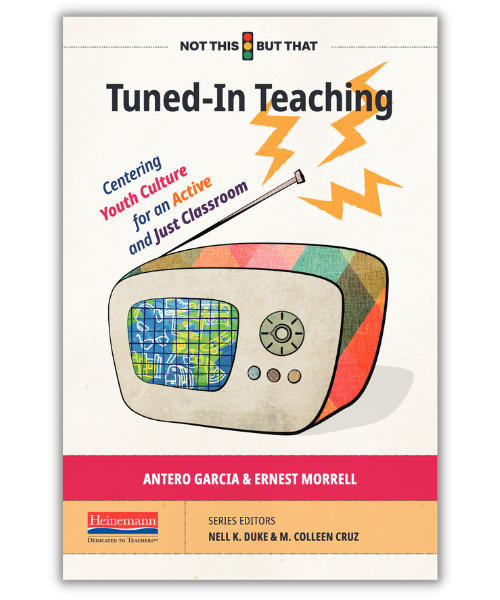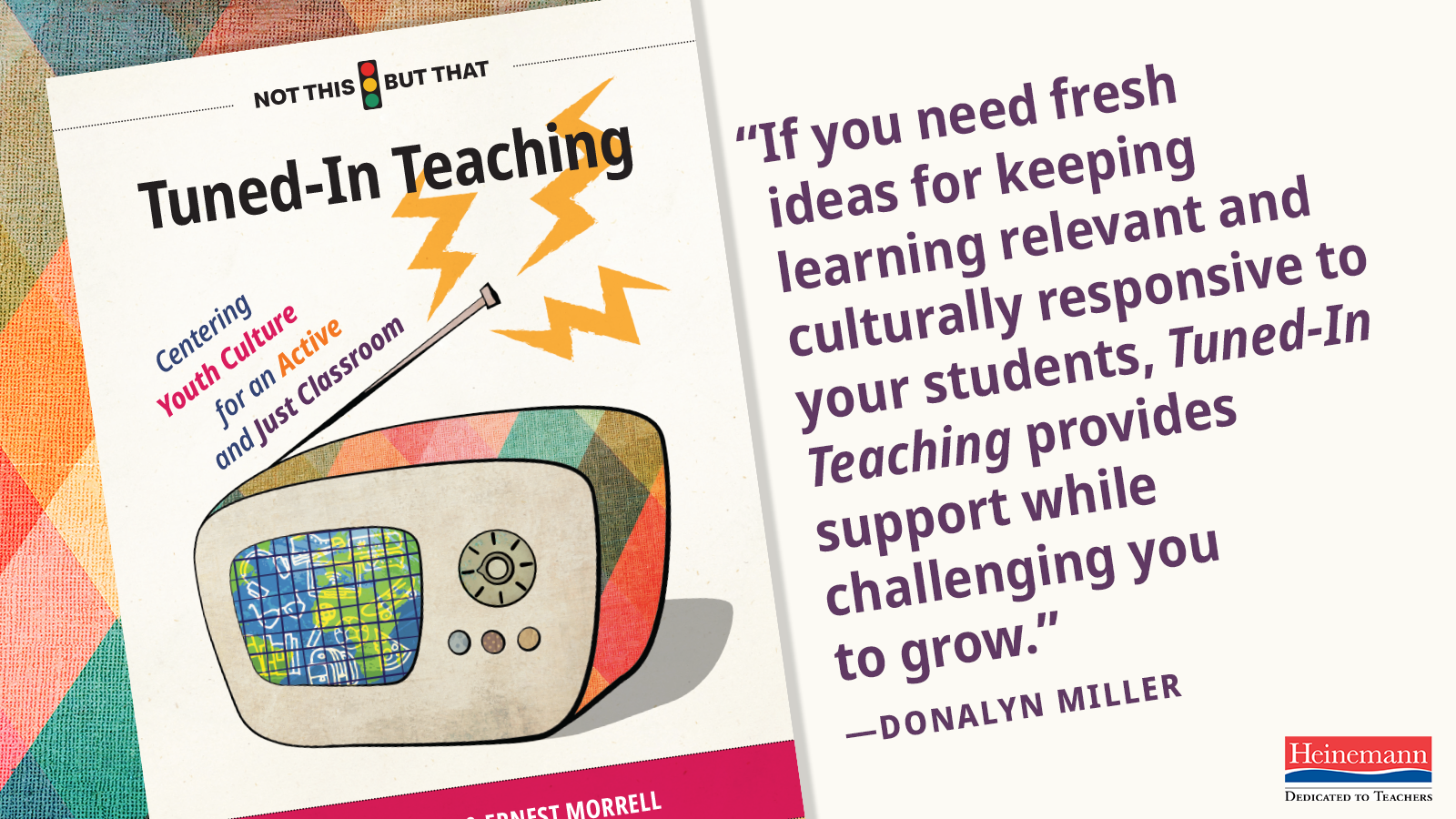
What is "Out of Touch" Teaching? (And How to Combat it)
What is "Out of Touch" Teaching? (And How to Combat it)
The world that today's students are learning and interacting in is different from the one most of us grew up in.
In Tuned-In Teaching: Centering Youth Culture for an Active and Just Classroom, coauthors Antero Garcia and Ernest Morrell use the term "out-of-touch teaching" to call attention to these differences—differences that can impact engagement. Then they provide support for making any classroom a more tuned-in place.
What is "out of touch" teaching?
Out-of-touch teaching refers to pedagogical choices, interactions with students, and instructional materials that:
- do not make an immediate impact on the lives of students
- do not actively work to transform the social conditions of schooling
- do not connect with the interests and expertise of contemporary students in the present world.
In the context of middle and high school classrooms, such approaches show up in various aspects of instruction and increase an out-of-touch feeling.
5 aspects of teaching worth considering
Here are five aspects of teaching worth considering when it comes to increasing student engagement:
Text and curricular selections
Who writes or chooses the texts and materials that students interact with?
How writing and communication are taught
Who are the implied and explicit audiences for student writing? Do students have autonomy to determine what modes of writing to try?
Relationships with students
How do you get to know your students? How do you engage with them?
Your own (shifting) interests as a teacher
Is your curriculum at all reflecting the ideas, topics, and content that you’ve been interested in? Do you give yourself space to breathe and grow in your work?
The world beyond the classroom
How do your students engage with or disregard the sociopolitical, emotional, geographic, digital, and analog world beyond your school?
By carefully monitoring and focusing on these aspects, we can start pivoting toward more tuned-in teaching.
What inhibits tuned-in teaching?
Understand that struggling with an out-of-touch feeling is common! Despite the reality that we can naturally slide out of touch in our practice, there are important reasons why instruction might not be in tune.
As we work on improving our practice—both collectively and individually—we also must recognize that there are substantial problems inhibiting the teaching profession and the act of teaching joyfully: Dwindling school funding, an overemphasis on assessment performance, and the stratification of learning opportunities based on socioeconomic difference.
The reasons educators struggle are profound and adversely affect the learning (and life) outcomes of adolescents—particularly students from Black, indigenous, and nondominant communities. In fact, you may find that making your lessons more tuned-in can naturally promote your own role as an advocate pushing against the very reasons classrooms may be out of touch to begin with.
Greater engagement in the classroom
Tuned-In Teaching goes into depth about the pitfalls of out-of-touch teaching and offers an orientation for creating a more responsive classroom.
Putting positive steps into action can often feel challenging. That's why this is also a handbook for beginning to intentionally change yours into a classroom of engagement: one that is transformative for your students and revitalizing for you.
Actions that combat out-of-touch teaching
In Tuned-In Teaching, Garcia and Morrell describe six important actions for transforming classrooms into an active, just, and in-touch space:
- Students at the Center: How are you ensuring you are fully seeing who your students are?
- Authenticity as a Standard: How do students’ interests and expertise get to shine?
- Get in Touch with Student’s Digital Lives: How can technology be used meaningfully in your instruction?
- Keep It Playful: How is student curiosity cultivated in your classroom?
- Center Action: Who are the audiences your students communicate with?
- Put It All Together: How do you assess learning in your classroom?
- Below, you'll find support for starting to think about one of these actions: harnessing playfulness to combat out-of-touch teaching.
Learn to keep it playful
When we imagine the world that we want a child to eventually lead, live, and succeed in, there is an abundance of big tasks that need to be accomplished. Systemic inequities are problems that plague our society and have gone unaddressed for generations. That being said, each child (at any grade level) must also have opportunities to play, to be wildly imaginative, and to laugh.
Questions to ask about playfulness
As you work to improve your classroom instruction, look over your plans and consider:
- How often is laughter cultivated on a daily basis?
- When are students provided opportunities to play, strategize, and consider learning from a game-based perspective?
- What imaginative activity is part of students’ reading, writing, and communication?
Important learning can also be fun
Enthusiasm and levity are important. Getting tuned in with effective teaching for students requires remembering that a joyful life (and joyful learning) can be cultivated in our classrooms. Just because the work we do is important does not mean that an activity cannot be fun.
Educators consistently hope that students will enter into work around something they are passionate about. Our behaviors as teachers can create opportunities for levity, show our smiling humanity, and demonstrate our own enthusiasm for our curriculum to affirm this side of civic life to our students.
Depending on your context, this could mean an activity like exploring political humor on shows like Saturday Night Live, or perhaps remixing classroom content in ways that create parody and jokes shared by your students.
Games and play help students engage
Furthermore, games and play are an important way for students to understand complex systems and situations that may shape their experiences beyond the real world. An existing game can quickly become an activity used for learning in your classroom.
Educator Allan Johnson (2001), for example, has highlighted simple modifications to the game of Monopoly to teach about systemic inequality. As a game initially meant to critique systems of capitalism, Monopoly plays a unique role in popular culture today: it has sold millions of copies, nearly everyone in the United States knows the basic rules of the game, and (at least in our experience) most people don’t actually like the game that much! As a game that is easy to acquire, it is a great opportunity to explore a myriad of issues and to improve a game play experience that most people find mundane.
Likewise, even social group games like Werewolf, Apples to Apples, and Game of Phones allow students to communicate with their peers, collaborate, and smile in ways that traditional curriculum often gets in the way of. Playing in classrooms provides opportunities for students to build relationships in new ways and potentially connect games to content-focused curriculum.
Games can frequently offer a systems-focused perspective of how mechanisms like inequality operate throughout society. (And they might just make in-touch teaching feel more fun for you personally.)
Playing toward justice
Creating opportunities for play and imagination in classrooms is also an issue of justice. If we consider the increased surveillance, criminalization, and adultization of Black and brown youth in communities today, the freedoms to explore and to be imaginative are cast as suspicious behaviors.
They are the policies that led to fourteen-year-old Ahmed Mohammed being handcuffed for bringing a homemade clock to school in 2015. Likewise, as schools frequently focus on test prep, opportunities for arts-based expression, learning, and exploration are being diminished.
Your classroom can be a center of joy
Trying to make your classroom a center of joy in the lives of your students and a place for playfulness may feel secondary to the many, many demands on your time as a teacher. This connection with play, however, is more than a trite activity; it is a suggestion that can level-up engagement.
Designing around the needs for play, imagination, and levity are often joyful processes (in and of themselves). Moving from spelling out for a group “This is how the world works” to having them question “What if the world worked like this?” is an opportunity for positive engagement and a strategy to benefit your lessons. It is work that's worth the effort.

Antero Garcia is an associate professor in the Graduate School of Education at Stanford University. He studies how technology and gaming shape youth learning, literacy practices, and civic identities. Prior to completing his Ph.D., Garcia was an English teacher at a public high school in South Central Los Angeles. Based on his research, Garcia co-designed the Critical Design and Gaming School—a public high school in South Central Los Angeles.
Ernest Morrell is the Coyle Professor, a member of the faculty in the English and Africana Studies departments, and Director of the Center for Literacy Education at the University of Notre Dame. Before finishing his Ph.D., he was a public high school English teacher in Oakland, CA. Ernest is also director of the National Council of Teachers of English (NCTE) for the James R. Squire Office of Policy Research in the English Language Arts.




